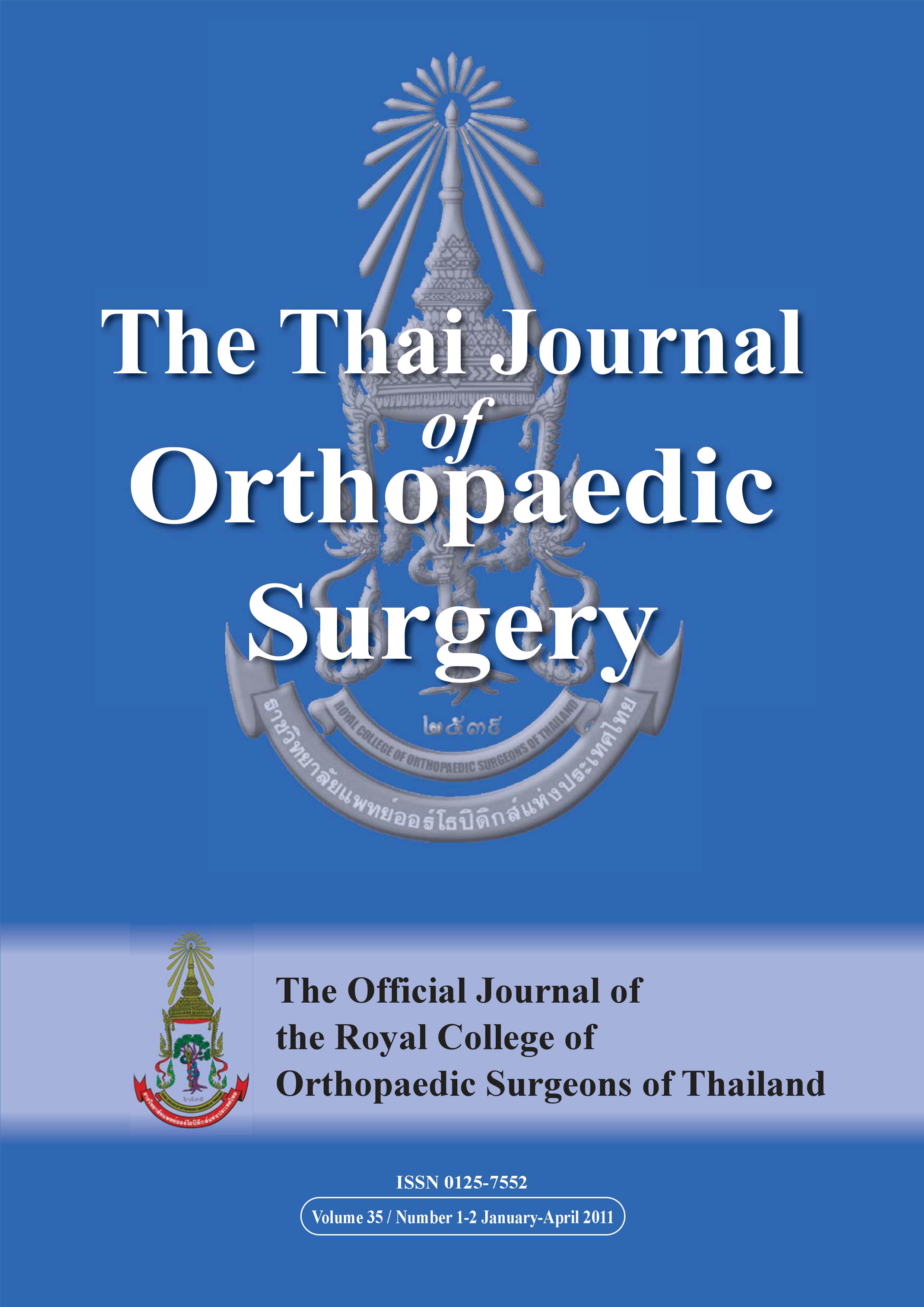Prevalence of Osteoporosis in Female Health Personnel as Measured by Quantitative Ultrasound
Main Article Content
Abstract
Purpose: To determine the prevalence and risk of osteoporosis as measured by quantitative ultrasound (QUS) in female health personnel aged 41-60 years, compared with the general female population.
Methods: A cross sectional study of bone mineral density (BMD) measured in females aged 41-60 years using both health personnel and the general population. T score of BMD derived from QUS was recorded and analyzed.
Results: The overall prevalence was higher in the general population than in health personnel (18.08% vs. 13.11%). The prevalence showed little difference between age groups of health personnel (15% vs. 12.19%), but a higher prevalence was demonstrated in health personnel, as compared to the general population in the 41-50 years age group (12.19% vs. 0%).
Conclusion: The younger age group of female health personnel had a relatively high prevalence of osteoporosis. Effective education and prevention should be implemented for these high risk female health personnel.
Article Details
References
2. Johnell O, Kanis JA. An estimate of worldwide prevalence and disability associated with osteoporotic fractures. Osteoporos Int. 2006; 17(2): 1726-33.
3. WHO Study Group. Assessment of fracture risk and its application to screening for postmenopausal osteoporosis. World Health Organ Tech Rep Ser. 1994; 843: 1-129.
4. Gregg EW, Kriska AM, Salamone LM, Roberts MM, Anderson SJ, Ferrell RE, et al. The epidemiology of quantitative ultrasound: a review of the relationships with bone mass, osteoporosis and fracture risk. Osteoporosis Int. 1997; 7: 89-99.
5. Hans D, Dargent-Molina P, Schott A, Sebert J, Cormier C, Kotski P, et al. Ultrasonic heel measurements to predict hip fracture in elderly women: The EPIDOS prospective study. Lancet. 1996; 348: 511-51.
6. Njeh CF, Biovin CM, Langton CM. The role of ultrasound in the assessment of osteoporosis: A review. Osteoporosis Int. 1997; 7(1): 7-22.
7. Rosenberg S, Twagirayezu P, Paesmans M, Ham H. Perception of osteoporosis by Belgian women work in a university hospital. Osteoporosis Int. 1999; 10: 312-5.
8. Frost ML, Blake GM, Fogelman I. Can the WHO criteria for diagnosis osteoporosis be applied to calcaneal quantitative ultrasound? Osteoporosis Int. 2000; 11(4): 321-30.
9. Chompootweep S, Tankeyoon M, Yamarat K, Poomsuwan P, Dusitsin N. The menopause age and climacteric complaints in Thai women in Bangkok. Maturitas. 1993; 17(1): 63-71.
10. Kanis JA, Melton LJ 3rd, Christiansen C, Johnston CC, Khaltaev N. The diagnosis of osteoporosis. J Bone Miner Res. 1994; 9(8): 1137-41.
11. Kanis JA. Diagnosis of osteoporosis and assessment of fracture risk. Lancet. 2002; 359(9321): 1929-36.
12. National Osteoporosis Foundation. Osteo- porosis: clinical updates. 2002. Available from: http://www.nof.org/cmexam/Issue1QUS/QUSOnlineCME.pdf Accessed Sept 1, 2010.
13. WHO Expert Committee. Physical status: the use and interpretation of Anthropometry. World Health Organ Tech Rep Ser. 1995; 854.
14. De Laet C, Kanis JA, Oden A, Johanson H, Johnell O, Delmas P, et al. Body mass index as a predictor of fracture risk: A meta-analysis. Osteoporosis Int. 2005; 16: 1330-8.
15. Robbins J, Schott AM, Azari R, Kronmal R. Body mass index is not a good predictor of bone density: results from WHI, CHS, and EPIDOS. J Clin Densitom. 2006; 9(3): 329-34.
16. Zochling J, Nguyen TV, March LM, Sambrook PN. Quantitative ultrasound measurement of bone: measurement error, discordance, and their effects on longitudinal studies. Osteoporosis Int. 2004; 15(8): 619-24.
17. Grampp S, Henk C, Lu Y, Krestan C, Resch H, Kainberger F, et al. Quantitative US of the calcaneus: cutoff levels for the distinction of healthy and osteoporotic individuals. Radiology. 2001; 220(2): 400-5.
18. Lim YW, Chan L, Lam KS. Broadband ultrasound attenuation reference database for Southeast Asian males and females. Ann Acad Med Singapore. 2005; 34: 545-7.
19. Yang NP, Jen I, Chuang SY, Chen SH, Chou P. Screening for low bone mass with quantitative ultrasonography in a community without dual-energy X-ray absorptiometry: population-based survey. BMC Musculoskeletal Disorders 2006; 7: 24. Available from: http://www.biomedcen
tral.com/1471-2474/7/24. Accessed Sept 1, 2010.
20. Limpaphayom KK, Taechakraichana N, Jaisamrarn U, Bunyavejchevin S, Chikittisilpa S, Poshyachind M, et al. Prevalence of osteopenia and osteoporosis in Thai women. Menopause. 2001; 8(1): 65-9.

